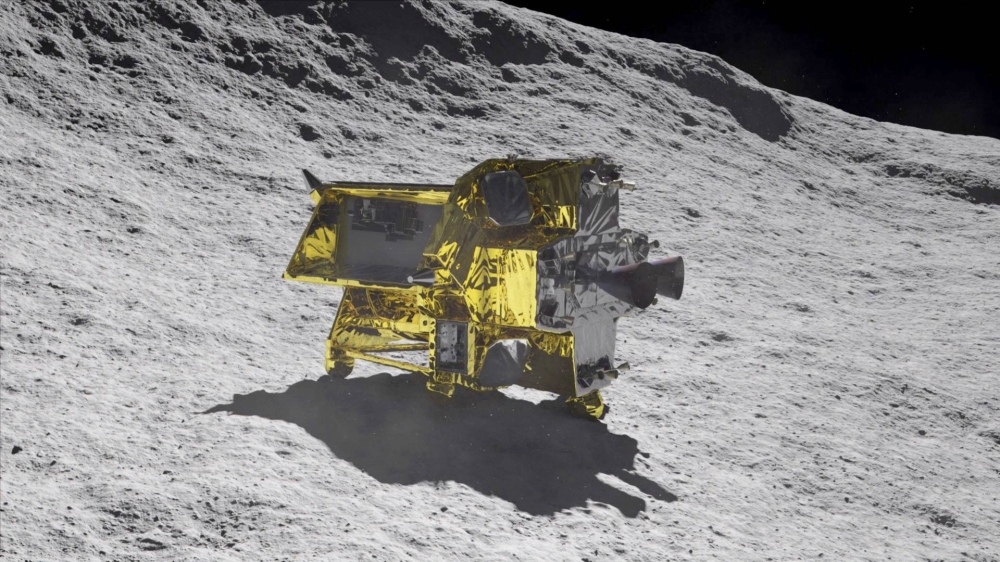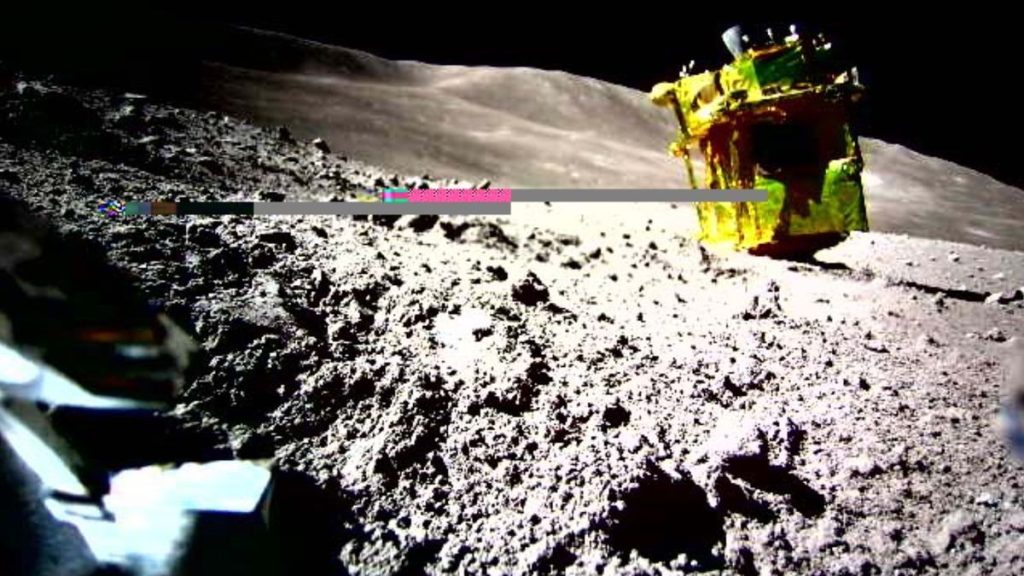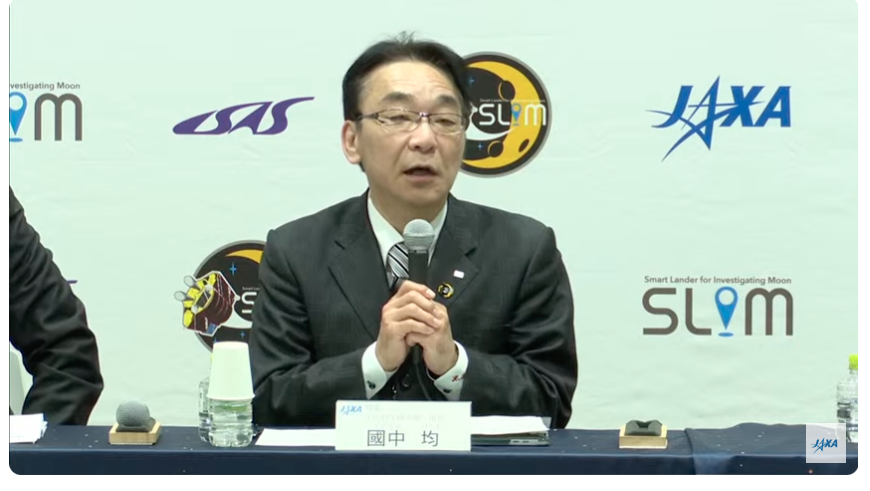UPDATED: Japan’s SLIM has woken up from a dormant state during the lunar night!
26th Dec 2023
Japan’s ambitious Smart Lander for Investigating Moon (SLIM) mission achieved a significant milestone on Christmas Day as it successfully entered lunar orbit. Developed by the Japan Aerospace Exploration Agency (JAXA), SLIM is now poised for a historic attempt to touch down on the lunar surface on Friday, 19th January, marking a crucial step for Japan in lunar exploration.
Japan’s SLIM Awakes!
Updated on 26th February
The Japanese SLIM module has woken up from from a dormant state during the lunar night and sent a signal to Earth.
It is not yet known how well the module’s instruments survived the cold lunar night. However, the Japanese space agency (JAXA) plans to continue communicating with SLIM.
SLIM “fell asleep” on 1st February shutting down and disconnecting from Earth. In this way, its instruments could endure extreme cold, reaching -170 degrees Celsius during the lunar night. Originally designed to operate for just two days, SLIM faced challenges as it couldn’t be activated for almost 10 days after landing due to a flip during landing, hindering sunlight access.
Recent communication attempts succeeded briefly. But connection was lost, likely due to overheating as the Sun is directly above the Shioli crater where SLIM landed. Despite this, experts anticipate SLIM to cool down soon and potentially resume operations if its instruments remain functional.
SLIM Moon Lander “Falls Asleep” During The Lunar Night
Updated on 5th February
In recent days, the panels have at last been exposed to sunlight, enabling SLIM’s communication with Earth. As the lunar night descends, the question arises: will it endure?
The inverted robot transmitted a continuous flow of data and images while its solar cells were properly aligned to absorb sunlight. The team managing it is optimistic that SLIM will reawaken and continue its operations after the lunar sunrise in mid-February.
Updated on 2nd February
The SLIM moon lander from Japan has captured its last images before entering a dormant state during the lunar night.
The spacecraft will remain inactive in the intense cold of the lunar night, with uncertainty about its potential reactivation thereafter.

Image Credit: JAXA
SLIM’s Successful Landing On The Moon
Updated on 25th January
JAXA confirmed the precision landing of the Moon Sniper, just 55 metres eastwards from the target, surpassing the initial goal of 100-metre accuracy. The agency also released the first images from the SLIM lander, taken by a mini-rover called LEV-2 (“Lunar Exploration Vehicle-2”) also known as SORA-Q, one of two tiny rovers that flew to the moon aboard SLIM. Photos revealed that Japan’s Moon lander ended up on its nose when it made its historic touchdown on the lunar surface.

“With this, SORA-Q became the first Japanese robot to land on the moon and take pictures,” Kintaro Toyama, chairman and representative director of the Japanese toy company Takara Tomy, which developed LEV-2 with JAXA, Sony and Doshisha University, said in a statement (in Japanese; translation provided by Google).
“This success is thanks to everyone involved and everyone who supported us as we pursued our dreams together,” Toyama added. “Thank you from the bottom of my heart.”
Updated [2] on 19th January
Japan became the fifth nation to land on the Moon as its Smart Lander for Investigating Moon (SLIM) touched down on the moon’s surface. Despite the successful landing, the Japan Aerospace Exploration Agency (JAXA) faced a challenge as SLIM’s solar panels are unable to generate electricity, possibly due to misalignment. The setback prompted a shift to battery operation, with a limited lifespan of a few hours.

In a press conference, Hitoshi Kuninaka, head of JAXA’s research center, highlighted the focus on prioritizing data transfer to Earth while maintaining the status quo to avoid risky actions. Despite implementing measures like turning off the heater for extended battery life, SLIM’s prospects hinge on a potential revival through changes in sunlight angles, a process that takes about 30 days on the moon.
“Looking at the trace data, SLIM most certainly achieved a landing with 100-meter accuracy,” affirmed Kuninaka, emphasizing the need for a month to verify the accomplishment. It’s a groundbreaking feat compared to conventional accuracy measured in kilometers.
Updated on 19th January
JAXA’s SLIM has landed on the lunar surface. Teams are still “checking the status” of the Smart Lander for Investigating Moon (SLIM) spacecraft several minutes after telemetry data confirmed the landing. The live stream is paused at 10:30 a.m. ET, pending official confirmation of a soft landing.
Updated on 17th January
Japan’s SLIM moon lander successfully executed an orbit-lowering maneuver on 14th January, transitioning from its initial 600 x 4,000-kilometer polar lunar orbit to a near-circular 600-kilometer orbit. The landing of the spacecraft is set for 19th January at 10:00 a.m. Eastern. The landing target is within 100 meters of a specific point on the slope of the Shioli crater.
After landing, SLIM will conduct experiments in the Shioli crater during the lunar day, utilizing its Multi-Band Camera (MBC) to assess the crater’s composition. The spacecraft is also carrying two small rovers, LEV-1 and LEV-2, equipped with cameras and science payloads for further exploration.
If SLIM successfully lands on the moon, Japan will become the fifth country to achieve a soft lunar landing.
Live coverage will commence an hour before the landing attempt.
SLIM Lander’s Journey
On 25th December 2023, at 2:51 a.m. EDT, SLIM reached lunar orbit as planned, covering an elliptical path that takes 6.4 hours to circle the Moon. At its closest point, SLIM comes within 373 miles (600 kilometres) of the lunar surface, extending out to 2,485 miles (4,000 km) at its farthest.
Launched on 6th September alongside the XRISM X-ray space telescope, the SLIM lander embarked on an energy-efficient route to the moon, leaving Earth’s gravity well on 30 September. Today’s successful insertion into lunar orbit sets the stage for SLIM’s upcoming touchdown attempt.
Dubbed the “Moon Sniper,” SLIM lander aims for a pinpoint landing accuracy of 330 feet (100 m) or less. JAXA emphasizes that this mission is vital for researching and demonstrating high-precision landing technology that will enable future lunar probes to target specific sites of scientific interest.
Additional Lunar Exploration Goals
If all goes according to plan, the 200kg SLIM lander will deploy two small probes to the lunar surface after landing. These probes will serve multiple purposes, including capturing images, monitoring SLIM’s status, and establishing an independent communication system for direct Earth communication. JAXA envisions SLIM’s success as a crucial step toward developing a lightweight lunar and planetary probe system that will facilitate more frequent exploration missions.
Until mid-January 2024, JAXA plans to lower SLIM’s apolune point, with the perilune point reaching an altitude of 15 kilometres on 19th January. The lander will initiate its descent towards the lunar surface on 20th January.
Global Lunar Exploration Context
While SLIM isn’t the first Japanese spacecraft to reach lunar orbit, its innovative technology and goals set it apart. JAXA, aware of the challenges of lunar landings, sees SLIM as a technology demonstrator with expertise transferable to future missions, including the Martian Moon eXploration (MMX) and lunar polar exploration.
JAXA’s commitment to advancing precision landing technology highlights the agency’s dedication to pushing the boundaries of space exploration. SLIM’s final approach to the lunar surface next month could mark a historic achievement for Japan in the realm of space exploration.
![Beauty of the Pink Moon And Lyrid Meteor Shower in This Week’s Best Astrophotos [19-26 April] Beauty of the Pink Moon And Lyrid Meteor Shower in This Week’s Best Astrophotos [19-26 April]](https://orbitaltoday.com/wp-content/uploads/2024/04/Pink-Moon-is-on-its-way-above-the-mountains-1-300x300.jpg)





Thank you for your comment! It will be visible on the site after moderation.